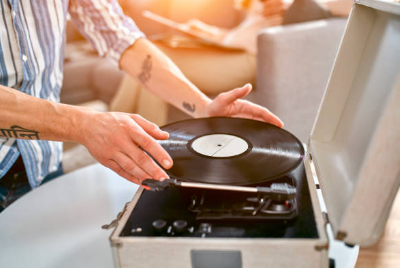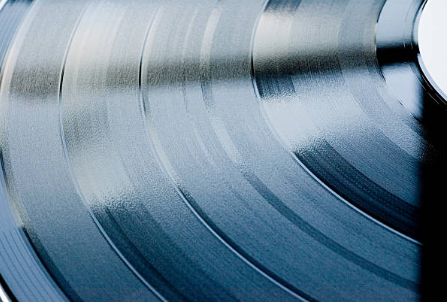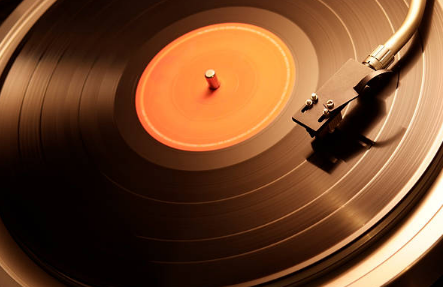How Do Vinyl Records Work? All Facts About Vinyl Records
How do vinyl records work? A record’s rotation generates sound vibrations that are then transformed into electrical signals. Inputs for electronic amplifiers include these signals. Speakers amplify and increase the volume of the sound after it is vibrated by electric amps. Continue reading, you will learn more facts about vinyl records.
Table of Contents
What is the History of Recording and Reproducing Sound?
Many of us take the ability to listen to music whenever and wherever we want for granted, but have you ever tried to imagine life without it? The only way to hear music before we learned how to record and playback sound were to have someone else play it or to play it oneself. Imagine how people’s understanding of recorded music would have changed drastically once they could listen to it on their own without someone performing it in front of them for the first time. You must first understand the beginnings and development of sound recording and reproduction in order to fully appreciate the genius of vinyl.
Over a century has passed since the first sound recordings and reproductions were made. Thomas Edison created the first recording and reproduction of sound in 1877, but it was on a metal cylinder rather than a disc. Emile Berliner, whose system played lateral-cut disc records that were first sold in Europe in 1889, coined the term “gramophone.” The vinyl record industry enjoyed its heyday from 1948, when the vinyl LP was first introduced, until 1988, when CDs overtook vinyl in sales. However, in 1962, when the Phillips Cassette was introduced, vinyl experienced its first taste of competition.
In January 2017, Vinyl sales in the UK surpassed three million, the highest level in 25 years. This is after decades in which music seemed to vanish into a computer hard drive. In 2016, record sales increased by 53% over the prior year to reach over 3.2 million. Vinyl continues to be the most impressive format for recording and reproducing music if you consider yourself to be a music enthusiast. We should therefore fully appreciate the genius of the vinyl record in order to honor it.
Sound Waves
Understanding how sound waves function is a prerequisite for appreciating vinyl’s genius. Waves, which are vibrating particles, which are how sounds travel through the air, are created by vibrations. The sound’s source radiates energy outward into its surroundings through the waves. When your eardrum vibrates due to moving air particles, your ear can detect sound waves. The sound is louder the larger the vibrations. The groove on a vinyl record is similar to a fingerprint of the sound waves that were recorded in a lacquer disc that we refer to as a vinyl record. This spiral groove on the vinyl record has three-dimensional cuts that capture the behavior of sound waves as they travel through the atmosphere.

The Stylus and the Grooves
A stylus, a type of needle used in typical record players, is gently positioned on the vinyl record, resting in the opening of the spiral groove. The stylus moves through the wavy three dimensions that are cut into the spiral groove as the vinyl disc steadily rotates. A tiny sapphire or diamond crystal is mounted as the stylus at the very tip of a thin metal bar that resembles a needle. The crystal’s microscopic bounces are transmitted down the bar as it vibrates in the groove. A piezoelectric crystal-containing electromagnetic device known as a cartridge and stylus are attached to each other at the end. An electrical signal is produced by the crystal’s slight wobbling caused by the metal bar pressing against it and moving back and forth. The sounds you hear through your speakers or headphones are created by these signals being fed into the amplifier. Not all record player cartridges convert sound vibrations into electrical signals using piezoelectricity. Inside some are a magnet and tiny electrical coils. To produce sound through your speakers, the stylus moves up and down past the coil, pushing the magnet past the coil and producing electrical signals. These electrical signals are then fed to the amplifier.
Many record collectors and DJs say the sound of vinyl is far superior and much “warmer” than digital music and this is why vinyl has always been the first choice for any music connoisseur. But this is untrue in terms of the facts. The Whittaker Nyquist Kotelkinov Shannon Sampling Theorem explains how, when using a band-limited signal, sound waves can be perfectly replicated by using a sampling rate twice as fast as the frequency limit.
How Do Vinyl Records Work?
How do vinyl records operate still baffle you? Except for physics geeks, understanding sound waves and electrical signals is challenging. Let’s dissect the procedure, then.
The Turntable Rotates the Vinyl Record
The turntable, also known as a platter or vinyl player, is the first thing you see when you want to play a vinyl record. The record will spin continuously with the help of this device. The diameter of the record affects speed.
The majority of long-play records (LPs) have a 12-inch disc diameter, multiple songs on each side, and a rotational speed of 33 1/3 revolutions per minute (RPM). Single discs typically have a 10-inch diameter and spin at a higher RPM of 45.
You might have single discs with a 7-inch diameter and a 78 RPM spinner if you have recordings from before the 1950s. The duration of the record, which can be anywhere between a few minutes and an hour or more, is determined by the turning speed.
The Stylus Reads the Record
A tonearm lowers the stylus onto the disc once it has begun to spin. While you might have to manually position the stylus on older turntables, modern record players do this automatically. Put the stylus on the edge if your model requires you to move the arm manually. From there, it will be moved by the turntable.
As the disc spins, the stylus moves along the grooves and bounces up and down following the record’s “fingerprint).

The Tonearm Conducts the Mechanical Energy to the Cartridge
As previously mentioned, vinyl record players transform mechanical energy into electrical energy using a transducer system. This system includes the tonearm, which is the thin metal bar connecting the stylus to the cartridge. Actually, this arm picks up and transmits the vibrations coming from the stylus to the cartridge.
The Cartridge Converts the Mechanical Energy into Electrical Energy
The vibrations received by the cartridge as mechanical energy are converted into electrical energy using a piezoelectric crystal or a magnet and electrical coils. The electrical impulses created by this electrical energy are then sent to an amplifier, where they are converted into sound.
The Amplifier Transfers the Sound to the Speakers
The amplifier is responsible for the final step, which is the transmission of sound from the speakers (or your headphones) to the speakers.
The diaphragm in these speakers (or headphones) follows the same pattern as the stylus in its back-and-forth motion. The sound you hear is the result of the air molecules vibrating as a result of the movement of the diaphragm.
How Do Vinyl Record?
You might be wondering how the original sound is recorded on vinyl records now that you are aware of how they operate when being played back.
In essence, we’re examining the polar opposite. During the vinyl recording process, the singer or producer converts sound waves into electrical signals using a microphone, which is also a transducer.
These signals are transmitted to an arm with a sapphire or diamond tip. This needle etches the grooves on an empty lacquer disc following the “fingerprint” transmitted by the microphone. The arm does this to convert electrical signals into mechanical signals that the stylus on your turntable can read.
What Are Sound Waves and What is Their Role?
Understanding sound waves is a prerequisite for understanding how vinyl records operate.
When particles in the medium through which they are moving to vibrate back and forth, they create mechanical waves called sound waves. Sound waves are essentially vibrating particles that move through the air.
Your ear hears the sound when these particles cause the vibration of your eardrums. This idea applies to all audio, not just vinyl records. Additionally, the sound is generally louder when there are larger vibrations.

In order to understand how our vinyl records function, let’s return to the grooves. If you’ve ever looked closely at the vinyl record’s surface, you may have noticed that each disc has spiral grooves that extend from the edge toward the center.
As a sort of fingertip of the sound recorded in the disc, these grooves are actually sound waves imprinted on the vinyl substrate. The way sound waves behave as they travel through the air and create the music we hear is determined by these grooves.
How to Prevent Poor Playback Quality?
Only when kept in ideal circumstances will a vinyl record produce good playback quality. This implies that you should regularly clean the record and take precautions to prevent accidental damage.
- Always store the records in their sleeves: Records should always be stored in their sleeves because even the smallest scratches can degrade playback quality. Only play or clean records; never remove them.
- Never touch the grooved area: Only touch the vinyl’s outer rim and label areas when handling it. Your skin oils and accidental touching of the grooves both have the potential to cause surface damage to the record.
- Use a sleeve liner: Anti-static sleeves called sleeve liners are placed inside the original paper sleeve. They stop paper and dust fibers from adhering to the vinyl surface.
- Clean the records regularly: After listening to the records, clean them with a carbon fiber brush or a soft brush from a record cleaner.
- Store your records properly: Records on vinyl ought to be kept out of direct sunlight and other sources of heat in a dry, cool environment. Keep in mind that vinyl is a type of plastic that may lose its shape when subjected to high temperatures.
How Do the Grooves Make Sound?
How does music come from the grooves on a vinyl record since they don’t produce sound on their own? The stylus comes into play here.
With a tiny sapphire or diamond set at the tip, the stylus resembles a needle. The electromagnetic cartridge, which includes a piezoelectric crystal or electrical coils and a magnet, is at the end of a light metal bar to which the needle is attached.
As a record spins during playback, the stylus travels through the tridimensional grooves on the disc. The metal bar transmits these minuscule bounces to the cartridge as the crystal at the stylus’ tip vibrates in time with the grooves.
Every time the metal bar moves, it presses against the crystal, creating an electrical signal that is sent to the amplifier. The sound you hear through the speakers is then produced by the amplifier.
Does the Record Weight Matter?
Although the weight of the record has no effect on the quality of the sound, a heavier record might last longer. In fact, a heavier disc is typically thicker, more durable, and less likely to be scratched or damaged. But heavier vinyl records are frequently more expensive than their more affordable counterparts.

Currently, the majority of standard records weigh between 120 and 140 grams, while heavier, audiophile-grade records can weigh up to 220 grams.
Conclusion on How To Do Vinyl Records Work
The stylus reads the record grooves after the vinyl record has been rotated on the turntable. The cartridge then transforms the mechanical energy into electrical energy after being conducted by the tonearm. When it reaches the speakers, the signal has been amplified.